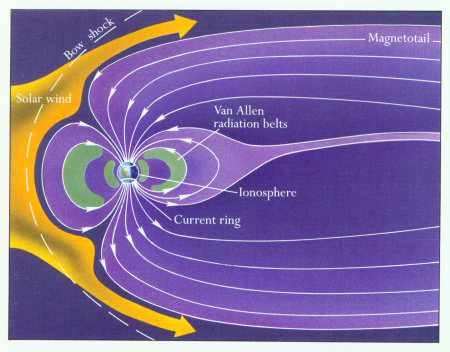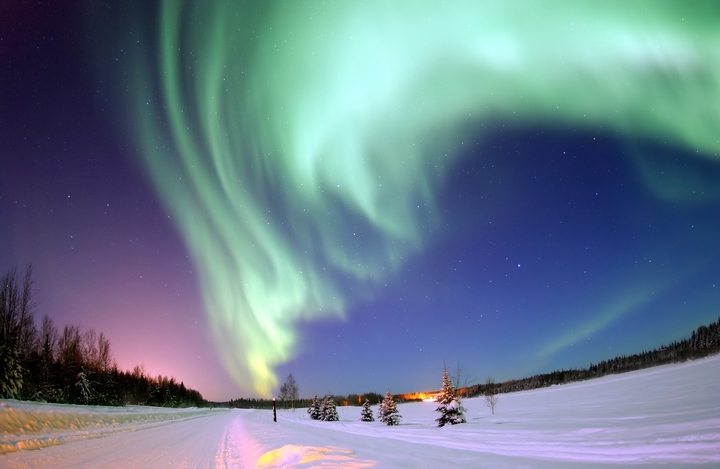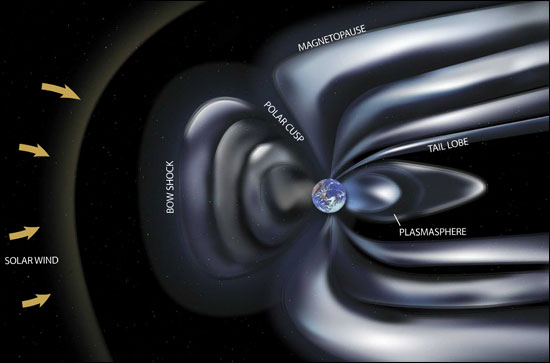
|
||||||||||||
|
|
|
Auroras Aurora Borealis-Aurora Australis Northern Lights-Southern Lights
Credit:Joshua Strang,USAF
From prehistoric times, humans have been fascinated by the waxing and waning of
auroral lights, the closest and most dramatic manifestation of space phenomena.
Spectacular auroral eruptions have given rise to mythological creatures, have
driven folklore, and have influenced the course of history, religion, and art.
The Sun is our nearest star. It is, as all stars are, a hot ball of gas made up mostly of Hydrogen. The Sun is so hot that most of the gas is actually plasma, the fourth state of matter.
The first state is a solid and it is
the coldest state of matter. As we heat up a solid it becomes liquid. Liquid is
the second state of matter. As we heat up liquid, the liquid turns to gas. Gas
is the third state of matter. As we heat up the gas, atoms break apart into
charged particles turning the gas into plasma.
Charged particles and magnetic fields influence each other. So when the solar wind, which is made up of charged particles, blows past Earth's magnetosphere, the shape of the magnetic field changes from the dipole magnetic field -- shown on Earth's Magnetosphere page -- to a plasma-swept magnetosphere that looks more like someone's hair got blown in the wind. This interaction between the Sun's plasma wind and Earth's magnetosphere is known as the Sun-Earth Connection.

The every day interaction between
the solar wind and Earth's magnetic fields causes currents to flow between
Earth's upper atmosphere and the magnetosphere, mostly the magnetotail. And just
as currents flow through a neon light to light up the gas, the currents flow
between the magnetotail and upper atmosphere light up Earth's gases to cause the
aurora.
People in the Northern Hemisphere have particular reason to keep an eye on the sun, both because of geography and geology. The region is relatively close to the magnetic North Pole, where solar disturbances often enter the Earth's atmosphere, and the granite bedrock below readily conducts surges of electricity.
If you are standing in the Northern Hemisphere on a clear dark night and looking up into the sky, you may see a bright greenish-white band of light that stretches across the sky from the East to the West. You are seeing the Northern Lights, also known as the Aurora Borealis. These types of lights also occur near the South Pole, where they are known as the Southern Lights and Aurora Australis.
The light from the aurora is caused by charged particles (mostly electrons) that come from inside the magnetosphere and then speed up to very high speeds as they barrel down along magnetic field-lines into the upper atmosphere. As they collide with the gas, they excite the atoms and molecules, which emit light when they relax from their excited state.
Though NASA scientists say the solar maximum this cycle may be more potent as the last one, society is more vulnerable to damage today because so much more technology orbits the Earth. Hundreds of satellites, most of them used for telecommunications, have been launched since 1989.
Geomagnetic Substorm over Asia NASA Polar Satellite image
In a worst-case scenario, they say solar storms could knock out all high-frequency radio on the sunlit side of the Earth or expose airplane passengers in northern latitudes (near the North Pole) to the equivalent of 100 chest X-rays.
Credit: NASA, SOHO, JPL , LASCO |












